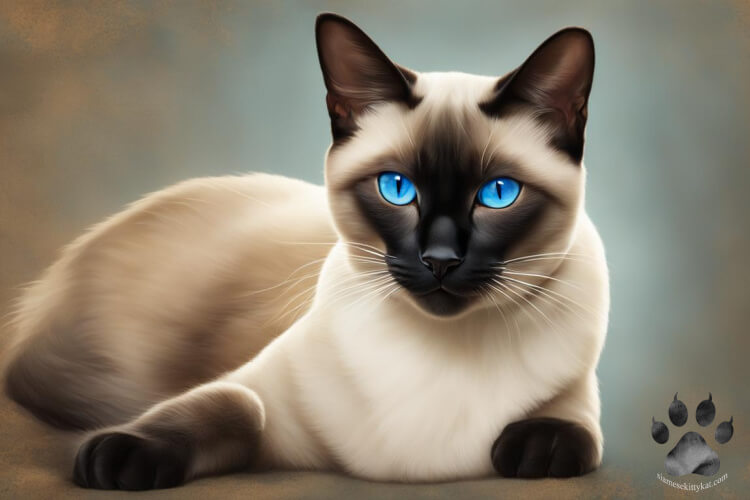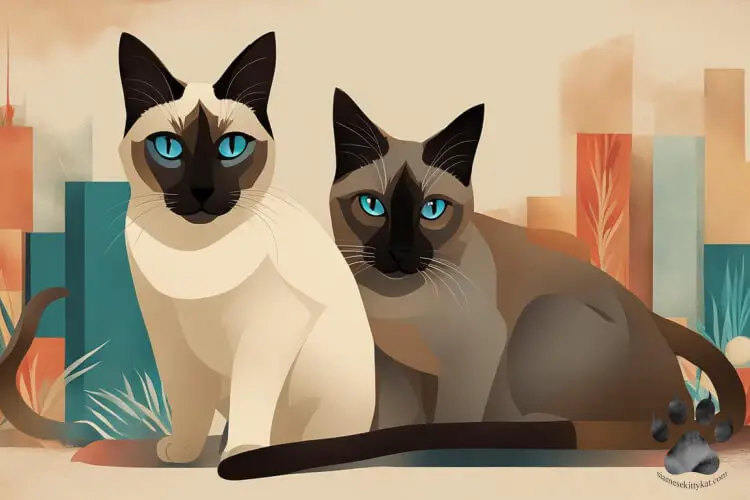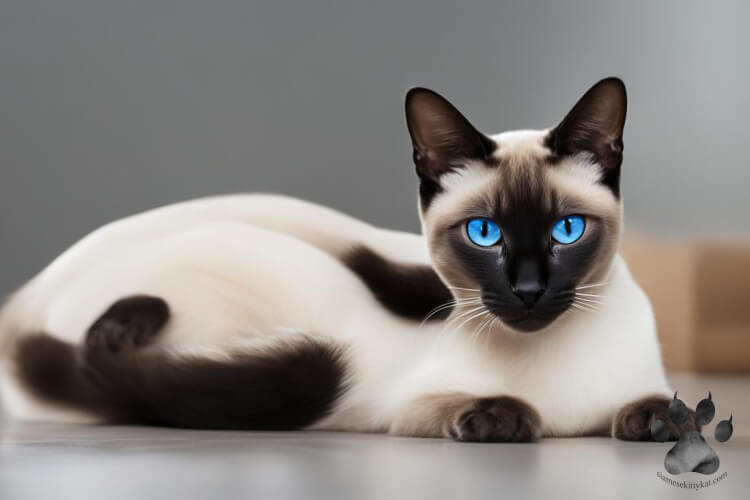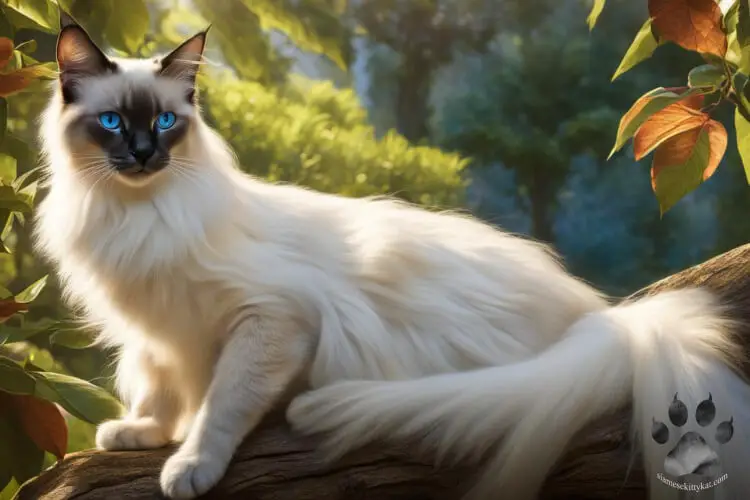As a cat lover, I have always been fascinated by Siamese cats. Their striking blue eyes and beautiful color points make them one of the most distinctive cat breeds out there. But there’s so much more to these felines than just their appearance. In this section, we will delve into the world of Siamese cat breeds, exploring their unique traits, fascinating history, and the different patterns that make them so special.

Siamese cats have a long and interesting history, with their origins dating back to ancient Siam, now known as Thailand. These cats were once worshipped as sacred animals and were owned only by royalty. Today, Siamese cats are popular pets all around the world and come in various breeds and patterns.
Key Takeaways:
Understanding Siamese Cat Breeds
Siamese cats are unlike any other breed. Known for their stunning blue almond-shaped eyes and unique color points, these cats are both beautiful and intelligent. But what exactly makes a Siamese cat? In this section, we’ll explore the defining characteristics of Siamese cat breeds.
Firstly, Siamese cats are usually slender with a muscular body, medium-sized, and weigh between 6 and 12 pounds. They have a triangular head shape and stand out via their sleek, short-haired coat.
“Siamese cats not only have a striking appearance but are also known for their affectionate and vocal nature. They are quite talkative and known for their intelligence, often described as having a dog-like personality.”
While most people recognize the Siamese breed from their color points, they also have several other distinct characteristics. For example, Siamese cats’ eyes are always blue and have almond-shaped pupils. Additionally, their vocalization skills are unparalleled, often with a unique chirping sound.
In terms of behavior, Siamese cats are sociable and love to be around their human companions. They crave attention and often follow their owners around the house. They are also highly intelligent, active and can quickly learn new tricks.

Overall, Siamese cats are truly unique and special felines. In the following sections, we will explore the traditional and modern Siamese cat breeds, as well as several crossbreeds, including Balinese, Oriental, Tonkinese, and Himalayan cats.
Traditional Siamese Cats
When most people think of Siamese cats, the traditional Siamese, also known as Thai cats, is often what comes to mind. These cats have a robust body and distinctive round head shape, making them easily recognizable. They are also known for their striking color points, which are darker on the face, ears, tail, and legs, with a lighter body.
Traditional Siamese cats have a rich history, originating from Siam, now known as Thailand. They were originally known as “wichien-maat” cats and were held in high regard by the Siamese people. In fact, they were often given as gifts to visiting dignitaries. It wasn’t until the 1800s that these beloved cats made their way to Europe and North America, where they quickly became popular pets.
Today, traditional Siamese cats are still cherished by many cat lovers for their affectionate and social personalities. They are intelligent and playful, often seeking attention from their human companions. They enjoy playing games, such as fetch, and love interactive toys.
If you are considering adding a traditional Siamese cat to your family, it’s important to note that they have specific grooming requirements due to their short, fine coat. Regular brushing is necessary to prevent matting and keep their coat sleek and shiny. They also require daily playtime and exercise to keep them happy and healthy.
The Differences Between Traditional and Modern Siamese Cats
While traditional Siamese cats are still beloved by many, in the 1950s, a new breed of Siamese cat, known as the modern or show-style Siamese, was developed. These cats have a more slender and elongated appearance compared to the robust build of the traditional Siamese. They also have larger ears and a more pointed wedge-shaped head.
Modern Siamese cats have a sleek, fine coat similar to the traditional Siamese, but their color points are more extreme, creating a dramatic contrast with their lighter body. They are also known for their affectionate and social personalities, often seeking attention from their human companions.
While both traditional and modern Siamese cats have their unique traits and personalities, it ultimately comes down to personal preference when choosing which breed is right for you.

Modern Siamese Cats
Modern Siamese cats, also known as the show-style Siamese, have a sleek and slender appearance with a triangular-shaped head. These cats have been selectively bred for their extreme features, resulting in a more elongated body, longer legs, and a wedge-shaped head.
Their coat is short, fine, and close-lying to the body, emphasizing their elegant and graceful physique. Modern Siamese cats come in a variety of colors, including seal point, chocolate point, blue point, and lilac point, which refer to their color points.

Despite their delicate appearance, modern Siamese cats are active and playful, with a love for attention and interaction. They are smart and curious, often getting into mischief if they are not given enough stimulation.
The Differences Between Traditional and Modern Siamese Cats
The differences between Traditional and Modern Siamese cats are vast. While Traditional Siamese cats have a round head shape and a more robust body, modern Siamese cats have a triangular head shape and a more slender body. The modern breed also tends to be more vocal and demanding, with a higher energy level than their Traditional counterparts.
Another difference lies in their temperament. Traditional Siamese cats are known for their social and affectionate nature, while Modern Siamese cats can be more independent and demanding of attention. Both breeds are intelligent and trainable and require mental and physical stimulation to thrive.
In conclusion, modern Siamese cats are a stunning breed with unique physical features and a playful, energetic personality. They may not be for everyone, but for those who appreciate their distinct appearance and lively temperament, they can make wonderful and entertaining feline companions.
Can a different cat breed give birth to a Siamese kitten? The short answer is Yes. Find out more about this possibility when you read the full article here: Breeding Siamese cats from non-Siamese cats
Balinese Cats
Have you ever seen a Siamese cat with long hair? If so, you likely caught a glimpse of a Balinese cat. At first glance, they may look like a long-haired Siamese, but they have their unique set of characteristics that make them stand out from the crowd.
One of the most striking features of the Balinese cat is their silky coat that’s similar to the flow of silk. They come in various colors and patterns, including seal point, chocolate point, lilac point, and blue point. Their coat requires minimal grooming, yet they love attention and regular brushing might help to maintain a shiny coat.
Balinese cats have a similar temperament to their Siamese relatives, they are known for being talkative, social, and intelligent. They love being the center of attention and will do what they can to please their human companions. This kind of personality makes them a great pet for families with children or other pets.
Just like most other Siamese breeds, Balinese cats are also prone to some health issues, including dental and respiratory problems. Routine visits to the vet are critical to ensure they are in good health. Feeding them quality food, giving them enough exercise, and keeping their living environment clean are some of the essential things you can do to help them stay healthy and happy.
Read more about the similarities and differences between Balinese and Siamese cats here: Siamese vs. Balinese Cats
Fun fact:
Despite their name, Balinese cats do not originate from Bali, Indonesia, but rather from the United States. They were named after the graceful Balinese dancers because of their elegant and graceful movements.

Oriental Siamese Cats
Oriental Siamese cats are a close relative of the Siamese breed, sharing many of the same traits, but with a broader range of coat colors and patterns. They are an intelligent, vocal, and affectionate breed, making them a popular choice among cat owners.
While Siamese cats have a limited range of accepted colors, Oriental Siamese cats come in a wide variety of shades and patterns. They can have solid colors, bi-colors, tabby patterns, and more. This breed is recognized by the Cat Fanciers’ Association (CFA), with over 300 color and pattern combinations recognized by the organization.
As with Siamese cats, Oriental Siamese cats are known for their social nature and loyalty to their human family. They love to be in the center of attention and will often follow their owner around the house, meowing for attention. These cats are also highly intelligent, curious, and agile.
Due to their curious nature, Oriental Siamese cats require plenty of stimulation and playtime to prevent boredom. Interactive toys and scratching posts are a great way to keep them entertained and prevent destructive behavior.
When it comes to grooming, Oriental Siamese cats have a short, fine coat that requires minimal maintenance. Regular brushing to remove loose hair is all that is needed to keep their coats shiny and healthy. In terms of health, Oriental Siamese cats may be more prone to certain genetic disorders, such as progressive retinal atrophy and amyloidosis. Owners should ensure that their cats receive regular veterinary checkups to prevent and detect any health issues early on.
Keep in mind that they are different from the Oriental Shorthair cat breed. Check out their differences here: Siamese Cats vs. Oriental Shorthair

“Oriental Siamese cats are incredibly playful and curious, always looking for the next adventure. They are also very loyal and will form a strong bond with their owner.” – Karen, Oriental Siamese cat owner
Tonkinese Cats
As a crossbreed between Siamese cats and Burmese cats, Tonkinese cats possess a unique combination of personalities and physical traits. These felines are active, playful, and highly affectionate towards their human companions.
Tonkinese cats have a muscular build and short, silky fur that comes in four different color patterns: solid, mink, pointed, and sepia. Their eyes are large, expressive, and can be blue, green, or a combination of both.
Due to their high energy levels, Tonkinese cats require regular exercise and playtime. Interactive toys and puzzles are great ways to keep them mentally stimulated and prevent boredom. They also enjoy the company of other pets, especially if they have a similar playful and social temperament.
When it comes to grooming, Tonkinese cats only require occasional brushing to remove loose fur. They are generally healthy and have a lifespan of 12-16 years. However, they may be prone to certain health issues such as dental disease, liver disease, and heart problems. Regular visits to the vet can help prevent and treat any potential health concerns.
“Tonkinese cats are very intelligent and quick learners. They are highly trainable and can learn various tricks and commands, making them great companions for those who enjoy teaching their pets new skills.”
If you’re considering adding a Tonkinese cat to your family, be sure to find a reputable breeder who follows ethical breeding practices. You can also adopt a Tonkinese cat from a local animal shelter or rescue organization. Whatever your choice may be, a Tonkinese cat will surely bring joy and companionship to your home.
Himalayan Cats
Himalayan cats are a breed that combines the striking beauty of Siamese cats with the luxurious long coat of Persian cats. These cats have a unique appearance that is a combination of both breeds, with the distinctive Siamese color points and stunning blue eyes.
As with any cat breed, it’s essential to understand their temperament and personality. Himalayan cats are known for their loving and docile nature, making them ideal for households with children or other pets. They are also intelligent and curious, making them great companions for those who enjoy interactive playtime with their furry friend.
Grooming
As a long-haired breed, Himalayan cats require regular grooming to keep their coat healthy and free of tangles. Daily brushing is recommended to prevent matting and hairballs. Regular bathing is also necessary to maintain their coat’s luster and cleanliness.
Tip: Use a metal comb and pin brush to groom a Himalayan cat.
Diet
Himalayan cats have specific dietary requirements to keep them healthy and happy. They require a high-quality diet with a balanced mix of protein, fat, and carbohydrates. It’s best to choose a diet specifically formulated for their age, weight, and activity level. As with any cat, always provide fresh water and avoid feeding them table scraps or other human food.
Exercise
Himalayan cats are not known for their high energy levels and tend to be sedentary. However, regular exercise is still essential to keep them healthy and to prevent weight gain. Interactive playtime with their owners or toys is an excellent way to exercise your Himalayan cat and bond with them.
In summary, Himalayan cats are a beautiful and docile breed that requires regular grooming, a balanced diet, and exercise to keep them healthy and happy. With their affectionate nature and unique appearance, they make excellent pets for families and cat lovers alike.
Siamese Cat Patterns (Color Points)
Siamese cats are renowned for their stunning coat patterns, which add to their distinctive appearance. The four types of Siamese cat patterns are seal point, chocolate point, blue point, and lilac point.
| Pattern | Characteristic |
| Seal point | A dark brown or black point color on a light fawn or cream-colored body. |
| Chocolate point | A lighter brown-colored point on an ivory body. |
| Blue point | A light gray or blue point color on a white body. |
| Lilac point | A pinkish-gray point on a white body. |
The point color of a Siamese cat is determined by the temperature of the body. The cooler parts of the body, such as the ears, nose, paws, and tail, have a darker color, while the warmer parts, such as the torso, have a lighter color.
The color points usually become more pronounced as the cat grows older. The patterns are also more prominent on the extremities of the body, such as the ears and tail.
Aside from these four, there are other lesser-known yet recognized Siamese cat color points:
Flame Point Siamese Cat or Red Point Siamese Cat
When selecting a Siamese cat, the pattern is a matter of personal preference. Each pattern has its unique charm and beauty, and all Siamese cats possess the same loving and affectionate temperament.
People often get confused between seal point vs. chocolate point and blue point vs. lilac point. Click the link to each comparison blog to read the full article.
Siamese Cat Personalities
If you’re looking for a loving and social feline companion, a Siamese cat might be the perfect match. These cats are known for their unique personalities and their ability to form strong bonds with their humans.
Siamese cats are highly intelligent and curious creatures, and they thrive on interaction and playtime. They love attention and will often follow their humans around the house, seeking affection and companionship. Many Siamese cats also enjoy playing fetch and learning new tricks.
Siamese cats are also known for their vocal nature. They have a distinctive meow that they use to communicate with their humans, often demanding attention or expressing their opinions on various matters. Some Siamese cats are more talkative than others, and their vocal nature is part of their unique charm.
Despite their social and affectionate nature, Siamese cats can be quite independent. They have a strong personality and are not afraid to let their humans know what they want. However, they are also very adaptable and can easily fit into any household with proper care and attention.
Siamese cats are not recommended for households where they will be left alone for long periods, as they thrive on interaction and companionship. They also require mental and physical stimulation to stay happy and healthy, so make sure to provide them with plenty of toys and playtime.
Siamese Cat Care
As a proud Siamese cat owner, I can attest to the fact that these feline companions require proper care to lead happy and healthy lives. Here are some tips to ensure your Siamese cat thrives:
Diet
A healthy diet is essential to keep your Siamese cat in optimal health. Siamese cats have a higher metabolism and require more protein than other breeds, so it’s essential to provide a diet that includes high-quality protein sources. I recommend feeding your cat a diet rich in animal-based protein, with limited carbohydrates, and staying away from grain-heavy diets.
Exercise
Siamese cats are active and playful, and regular exercise is necessary for them to stay healthy and happy. Providing your cat with interactive toys and playtime can stimulate their minds and prevent boredom. I recommend dedicating at least 20-30 minutes daily to playtime with your Siamese cat.
Grooming
Siamese cats have a short coat that requires minimal grooming. Weekly brushing to remove loose hair and to distribute oils through their coat is sufficient for most Siamese cats. However, if you have a Balinese or Himalayan Siamese, which have longer coats, you’ll need to brush them more frequently to prevent matting.
Health Considerations
Siamese cats are generally healthy, but they may be prone to certain health issues, such as dental problems and respiratory issues. Regular check-ups with your veterinarian can detect any underlying health issues early on and prevent them from becoming more severe.
Litter Box
Siamese cats are fastidious creatures and prefer a clean litter box. I recommend scooping the litter box at least once a day and providing a litter box for each cat in your household, plus one extra. Providing a variety of litter box types and locations can also be helpful.
Training
Siamese cats are intelligent and can be trained to do various tricks and behaviors. Positive reinforcement training, using treats and praise, can be an effective way to train your cat. You can teach them simple commands like sit, stay, and come, or more complex tricks like high five or roll over.
Check out this complete guide on taking care of Siamese cats: Siamese Cat Health and Care
Comparing Siamese Cats with Other Cat Breeds
Siamese cats have so many look-alikes in the feline world. Sometimes it’s hard to tell them apart. Discover more about the uniqueness of Siamese cats in these breed comparison blogs:
Finding a Siamese Cat
Are you ready to bring home a Siamese cat? The first step is finding a reputable breeder or adoption center.
The Siamese Cat Society of America (SCSA) is a great resource for finding breeders and rescue organizations in your area. They also provide information on Siamese cat shows and events happening in your state.
If you’re interested in adopting, check with local animal shelters or rescue organizations. Many Siamese cats end up in shelters due to the high demand for purebred cats. (Here’s how to determine if a Siamese cat is purebred: What is a Purebred Siamese Cat?)
Adopting a rescue cat not only saves a life but can also be a more affordable option.
When you’ve found a potential breeder or adoption center, schedule a visit to meet the cats and ask any questions you may have about the breed’s care and temperament.
Here’s a comprehensive guide about everything you need to know about adopting Siamese cats and kittens: Siamese Cat Adoption 101
Bringing Your Siamese Cat Home
Before bringing your new furry friend home, make sure you have all the necessary supplies, including a litter box, food and water dishes, scratching post, and toys.
Siamese cats are social and thrive on attention, so make sure you have enough time to spend with them each day. They also require daily exercise and playtime to keep them mentally stimulated.
Caring for Your Siamese Cat
Proper care is essential for a healthy and happy Siamese cat. Make sure to keep up with regular vet visits and vaccinations. Siamese cats are prone to dental issues and may require professional tooth cleaning in addition to regular brushing at home.
Siamese cats have short hair that requires minimal grooming. However, they do shed, so regular brushing can help keep shedding under control. They also need a high-quality diet that meets their nutritional needs.
FAQ
What makes Siamese cats special?
Siamese cats are known for their distinctive blue almond-shaped eyes and striking color points. They are also known for being affectionate and vocal. Read more about their special characteristics here: Interesting Traits that Make Siamese Cats So Special
What are traditional Siamese cats?
Traditional Siamese cats, also known as Thai cats, are the original Siamese breed. They have a robust body and a distinctive round head shape.
What are modern Siamese cats?
Modern Siamese cats, also known as the show-style Siamese, have a more refined and slender appearance compared to traditional Siamese cats.
What are Balinese cats?
Balinese cats are a longhaired variant of the Siamese breed. They have a luxurious medium-length coat.
What are Oriental Siamese cats?
Oriental Siamese cats are close relatives of the Siamese breed and share similar traits but with a wider range of coat colors and patterns.
What are Tonkinese cats?
Tonkinese cats are a crossbreed between Siamese cats and Burmese cats. They exhibit a combination of characteristics from both breeds.
What are Himalayan cats?
Himalayan cats are a cross between Siamese cats and Persian cats. They have the Siamese color points and striking blue eyes, combined with the long and luxurious coat of Persian cats.
What are the different Siamese cat patterns?
Siamese cats come in various patterns, including seal point, chocolate point, blue point, and lilac point.
What are the personalities of Siamese cats?
Siamese cats are known for their loving and social personalities. They are intelligent and often form a unique bond with their human companions.
How should I care for my Siamese cat?
Proper care for Siamese cats includes grooming, dietary considerations, exercise, and specific health considerations for the different Siamese breeds.
How can I find a Siamese cat?
If you’re looking to add a Siamese cat to your family, we can provide information on reputable breeders, adoption options, and tips for bringing your new feline friend home.

